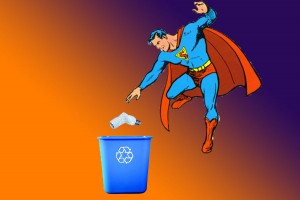It’s a Bird, It’s a Plane…

The best thing about Halloween is trying on a different identity for a night, being someone else entirely. And what a perfect time to rip off my glasses and shirt to expose a large “S” on my chest… to become the Environmental Superman.
As the Environmental Superman began her adventures, she realized that she would first need a large dosage of training. This took on the form of research and suggestions on how to help limit her (and others’) plastic consumption. Consumers understand that excessive trash and waste is bad for the environment, but the Environmental Superman had not considered that, “…plastics are also a common component of marine debris… entering the municipal solid waste stream,” and increasing from 1% to 12% of the total solid waste stream between 1960 and 2007 (“Prevention, Control, and Reduction: Plastics.” 1). The largest category of plastics in the land-based solid waste stream are containers and packaging for goods, seen in high numbers in items like soft drink or shampoo bottles , and some end up in the ocean (“Prevention, Control, and Reduction: Plastics.” 1). “Hmm,” thought Environmental Superman, “So effectively managing plastics could be as easy as recycling these common items and sticking to the ‘reduce, reuse, and recycle’ mantra?” Partially true. Limiting plastic consumption can also work on the manufacturing and municipal levels. For example, when the weight of a 2-liter plastic soft drink bottle was reduced from 68 grams to 51 grams in 1977, it resulted in a 250 million pound decrease of plastic per year for the waste stream (“Prevention, Control, and Reduction: Plastics.” 1).
However, Environmental Superman was only beginning her journey and had not accessed enough power to curb the manufacturing level. She also knew that the city of Easton had fairly recently implemented a single-stream recycling project, which eased the process for citizens. Thus, when she read that, “Individuals play an important role in preventing marine debris… by disposing of trash properly,” she knew that she could still make a positive impact just by changing her habits (“What You Can Do.” 1). Limitations to individual green habits might be, “the decreased demand of products manufactured from previously used plastic materials,… lack of information and logistical problems in collecting plastic materials,” (Flores, 1).
What can people do to limit plastic consumption? 1) Avoid purchasing products with excessive packaging 2) Find opportunities to replace disposable goods with reusable items 3) Recycle as much of your trash as you can and follow guidelines 4) Don’t litter 5) Publicize the need to limit plastic consumption to friends and family (“What You Can Do.” 1).
It seems simple enough to not buy or use simple plastics, but it’s hard to quell evil when it’s designed as a fashionable marketing and convenience tool. I’ve been able to reuse a water bottle, have a reusable bag on hand for purchases, say ‘no bag please’, and sneak straws back to the front counter when handed to me. But here’s the problem: many times, plastic is forced upon us. “Avoid purchasing products with excessive packaging”? Yeah, right, I can’t even buy potatoes without having them wrapped in shiny waste. In fact, packaging and containers, “…made up the largest portion of trash generated in 2007,” at 78 million tons (“Municipal Solid Waste Generation,…” 6). Another issue: no one really takes me seriously. Carrying my 10 pound bag of potatoes really won me some brownie points as that weird eccentric that doesn’t use plastic.
What did Environmental Superman do when her friends thought her antics were strange? That’s right, invite them on a bonding experience of picking up litter and recycling it together! Except Environmental Superman’s friends laughed at her instead. Luckily one friend from class, Shawn, decided to join her on a quest to recycle litter from around the area later tonight. By saving 85 million tons of municipal solid waste, we can save the energy equivalent of around 10.7 billion gallons of gas (“Prevention, Control, and Reduction: Plastics.” 1). Maybe I’m not and Environmental Superman, but changing recycling habits together can make a superhuman impact.
Works Cited
Flores, Mario C. “Plastic Materials and Environmental Externalities:Structural Causes and Corrective Policy.” Plastic Materials and Environmental Externalities. N.p., n.d. Web. 3 Nov. 2013. <http://www.lurj.org/article.php/vol3n2/plastic.xml>.
“Municipal Solid Waste Generation, Recycling, and Disposal in the United States: Facts and Figures for 2007.” EPA. EPA, Nov. 2008. Web. 2 Nov. 2013. <http://www.epa.gov/epawaste/nonhaz/municipal/pubs/msw07-fs.pdf>.
“Prevention, Control, and Reduction: Plastics.” EPA. N.p., n.d. Web. 2 Nov. 2013. <http://water.epa.gov/type/oceb/marinedebris/prevention_plastics.cfm>.
“What You Can Do.” EPA. N.p., n.d. Web. 2 Nov. 2013. <http://water.epa.gov/type/oceb/marinedebris/what_index.cfm>.
Leave a Reply